Unit - 1
Fundamentals of Microcontrollers
Q1) Explain 8-bit Microcontroller architecture.
A1)
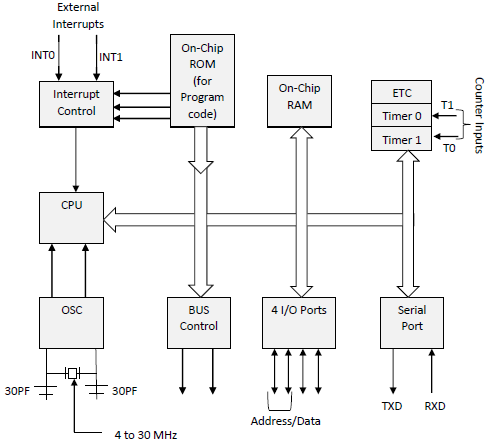
Fig 1: 8051 Architecture
Central Processor Unit (CPU)
The brain of any processing device of the microcontroller is the CPU. It monitors and controls all operations performed on these units. It reads a program written in ROM memory, executes and does the expected task.
Interrupts
Interrupt is a subroutine call that interrupts the microcontroller's main operations or work and causes it to execute any other program, at the time of operation. It provides a mechanism to put on hold the ongoing operations, execute a subroutine and resume to another type of operation.
8051 has five interrupt sources:
INTO
TFO
INT1
TF1
R1/T1
(INT0) ̅ and (INT1) ̅ are external interrupts negative edge triggered or low level triggered. When these interrupts are activated, the corresponding flags are set except for serial interrupts.
When the processor branches to ISR the interrupt flags are cleared. The external interrupts are timer and serial port interrupts.
Memory
They require memory to save as well as read so that the microcontroller performs specific operations of the task.
The memory which is used to store the program is known as code memory or Program memory. It is also known as ROM memory.
8051 data memory is used to store data temporarily for operation known as RAM memory. It has 4K of code memory or program memory and 128 bytes of data memory of RAM.
BUS
A collection of wires that work as a communication channel or medium for transfer of data. It consists of 8, 16 or more wires of microcontroller. Thus, they carry 8 bits or 16 bits of data simultaneously. There are two types of buses which are
Address Bus
Data Bus
Address Bus:
Microcontroller 8051 has a 16-bit address bus for transferring data. It addresses memory locations to transfer addresses from CPU to Memory. It has four addressing modes that are:
Immediate addressing modes.
Bank address (or) Register addressing mode.
Direct Addressing mode.
Register indirect addressing mode.
Data Bus: Microcontroller 8051 has 8 bits of data bus used to carry data for applications.
Oscillator
The 8051 microcontroller has an on-chip oscillator that acts as a clock source for the CPU of the microcontroller. The output pulses of the oscillator are stable. Therefore, it enables synchronized work for all the parts of the Microcontroller system.
Input/Output Port
To control the operation of machines, microcontrollers are used in embedded systems. To connect to other machines, devices or peripherals I/O interfacing ports is required. Microcontroller 8051 has 4 input and output ports to connect to other peripherals
Timers/Counters
The 8051 microcontroller has two 16-bit timers and counters. The counters are again divided into 8-bit registers. Timers are used for measurement of time intervals to determine pulse width.
Q2) Define embedded system and explain its characteristics?
A2)
An embedded system can be a computer hardware system having software embedded in it. An embedded system can be an independent system or it can be a part of a large system. An embedded system is a microcontroller or microprocessor based system designed to perform a specific task.
For example, let us consider the fire alarm as an embedded system. This system only senses smoke.
An embedded system consists of three components −
It has hardware.
It has application software.
It has a Real Time Operating system (RTOS) which defines the way the system works. It sets the rules during the execution of the application program. A small scale embedded system may not have RTOS.
Characteristics of an Embedded System
Single-functioned − An embedded system usually performs a specialized operation and does the same repeatedly. For example: A pager always functions as a pager.
Tightly constrained − All computing systems have constraints on design metrics, but those on an embedded system can be especially tight. Design metrics is a measure of an implementation's features such as its cost, size, power, and performance
Reactive and Real time − Many embedded systems must continually react to changes in the system's environment and must compute certain results in real time without any delay.
Memory − It must have a memory, as its software usually embeds in ROM. It does not need any secondary memories in the computer.
Connected − It must have connected peripherals to connect input and output devices.
HW-SW systems − Software is used for more features and flexibility. Hardware is used for performance and security.
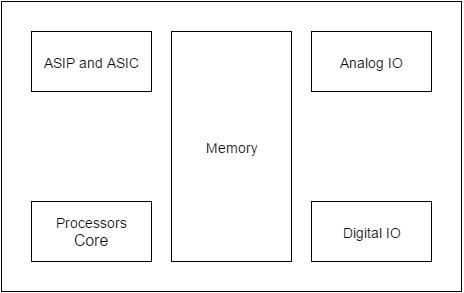
Q3) Compare 8-bit,16-bit,32-bit microcontrollers?
A3)
Most 8-bit processors are old architectures, so they tend to be slower. They are cheap. They also tend to have a low limit on supported RAM/other storage, but the actual amount depends on the family.
16-bit processors tend to focus on price as well, but there is a large range of parts available, some of which have fairly high performance and large amounts of on-chip peripherals. These parts usually perform faster than 8-bit parts on math where the precision is greater than 8 bits, and tend to have more addressable memory.
32-bit chips compete primarily on performance for an application. There is a considerable range of 32-bit parts available, each targeted at some specific application. They tend to come loaded with peripherals and compete on feature completeness. They have a large amount of addressable memory and the performance tends to be better than 16-bit parts.
Q4) With an example explain microcontrollers in embedded system?
A4)
Microcontroller is used inside an embedded system for managing the function of devices. Therefore, 8051 uses the two 16 bit counters and timers. For the operation of this timers and counters the oscillator used inside microcontroller.
Embedded System is a system unit that is used to create any automation device or to control any machines using Micro Controller.
Micro Controller is an Integrated Circuit that has a processor, Memory, Timer. A micro controller can be programmed with any dedicated task.
Consider the example of Washing Machine:
In a washing machine there are different functions that is programmed in a Micro Controller, like for rotating the motor and for automatic filling the water.
The whole circuit that uses different integrated circuit for different task can be called as Embedded System and the integrated circuit which is programmed for a dedicated task is called as a Micro Controller.
Q5) Compare Microprocessor and Microcontrollers.
A5)
| Microprocessor | Microcontroller |
System | It is the heart of the computer system, | It is the heart of an embedded system. |
Contains | It contains CPU, general purpose registers, stack pointers, program counters, clock timing and interrupt circuits. | It contains the circuitry of microprocessor and has built-in ROM, RAM, I/O devices, timers and counters. |
Data memory | It has many instructions to move data between memory and CPU | It has one or two instructions to move data between memory and CPU. |
Circuit | It is large | It is small |
Cost | Cost of the entire system increases | Cost of the entire system is low. |
Bit instructions | It has one- or two-bit handling instructions. | It has many bit handling instructions |
Register numbers | It has less number of registers; hence the operations are memory based. | It has more number of registers; hence the programs are easier to write. |
Storage | It is based on Von Neumann architecture, where the program and data are stored in the same memory module. | It is based on the Harvard architecture, where the program memory and data memory are stored in separate module |
Time | Access time for memory and I/O devices is more. | Less access time for built-in memory and I/O devices. |
Hardware | It requires more hardware | It requires less hardware. |
Q6) Explain the advantages of microcontroller?
A6)
i)Low time required for performing operation.
Ii)The processor chips are very small and flexibility occurs.
Iii)Due to their higher integration, cost and size of the system is reduced.
Iv)The microcontroller is easily to interface additional RAM, ROM and I/O ports.
Unit - 1
Fundamentals of Microcontrollers
Q1) Explain 8-bit Microcontroller architecture.
A1)
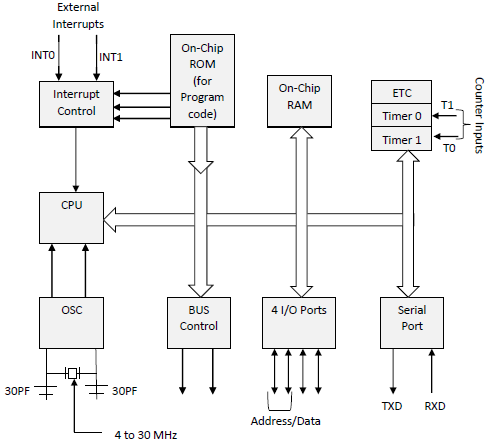
Fig 1: 8051 Architecture
Central Processor Unit (CPU)
The brain of any processing device of the microcontroller is the CPU. It monitors and controls all operations performed on these units. It reads a program written in ROM memory, executes and does the expected task.
Interrupts
Interrupt is a subroutine call that interrupts the microcontroller's main operations or work and causes it to execute any other program, at the time of operation. It provides a mechanism to put on hold the ongoing operations, execute a subroutine and resume to another type of operation.
8051 has five interrupt sources:
INTO
TFO
INT1
TF1
R1/T1
(INT0) ̅ and (INT1) ̅ are external interrupts negative edge triggered or low level triggered. When these interrupts are activated, the corresponding flags are set except for serial interrupts.
When the processor branches to ISR the interrupt flags are cleared. The external interrupts are timer and serial port interrupts.
Memory
They require memory to save as well as read so that the microcontroller performs specific operations of the task.
The memory which is used to store the program is known as code memory or Program memory. It is also known as ROM memory.
8051 data memory is used to store data temporarily for operation known as RAM memory. It has 4K of code memory or program memory and 128 bytes of data memory of RAM.
BUS
A collection of wires that work as a communication channel or medium for transfer of data. It consists of 8, 16 or more wires of microcontroller. Thus, they carry 8 bits or 16 bits of data simultaneously. There are two types of buses which are
Address Bus
Data Bus
Address Bus:
Microcontroller 8051 has a 16-bit address bus for transferring data. It addresses memory locations to transfer addresses from CPU to Memory. It has four addressing modes that are:
Immediate addressing modes.
Bank address (or) Register addressing mode.
Direct Addressing mode.
Register indirect addressing mode.
Data Bus: Microcontroller 8051 has 8 bits of data bus used to carry data for applications.
Oscillator
The 8051 microcontroller has an on-chip oscillator that acts as a clock source for the CPU of the microcontroller. The output pulses of the oscillator are stable. Therefore, it enables synchronized work for all the parts of the Microcontroller system.
Input/Output Port
To control the operation of machines, microcontrollers are used in embedded systems. To connect to other machines, devices or peripherals I/O interfacing ports is required. Microcontroller 8051 has 4 input and output ports to connect to other peripherals
Timers/Counters
The 8051 microcontroller has two 16-bit timers and counters. The counters are again divided into 8-bit registers. Timers are used for measurement of time intervals to determine pulse width.
Q2) Define embedded system and explain its characteristics?
A2)
An embedded system can be a computer hardware system having software embedded in it. An embedded system can be an independent system or it can be a part of a large system. An embedded system is a microcontroller or microprocessor based system designed to perform a specific task.
For example, let us consider the fire alarm as an embedded system. This system only senses smoke.
An embedded system consists of three components −
It has hardware.
It has application software.
It has a Real Time Operating system (RTOS) which defines the way the system works. It sets the rules during the execution of the application program. A small scale embedded system may not have RTOS.
Characteristics of an Embedded System
Single-functioned − An embedded system usually performs a specialized operation and does the same repeatedly. For example: A pager always functions as a pager.
Tightly constrained − All computing systems have constraints on design metrics, but those on an embedded system can be especially tight. Design metrics is a measure of an implementation's features such as its cost, size, power, and performance
Reactive and Real time − Many embedded systems must continually react to changes in the system's environment and must compute certain results in real time without any delay.
Memory − It must have a memory, as its software usually embeds in ROM. It does not need any secondary memories in the computer.
Connected − It must have connected peripherals to connect input and output devices.
HW-SW systems − Software is used for more features and flexibility. Hardware is used for performance and security.
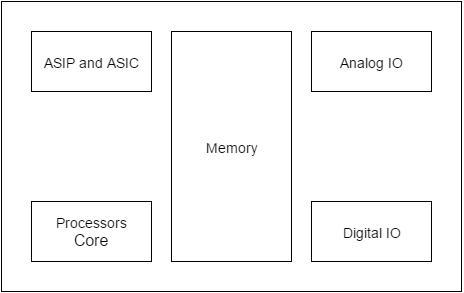
Q3) Compare 8-bit,16-bit,32-bit microcontrollers?
A3)
Most 8-bit processors are old architectures, so they tend to be slower. They are cheap. They also tend to have a low limit on supported RAM/other storage, but the actual amount depends on the family.
16-bit processors tend to focus on price as well, but there is a large range of parts available, some of which have fairly high performance and large amounts of on-chip peripherals. These parts usually perform faster than 8-bit parts on math where the precision is greater than 8 bits, and tend to have more addressable memory.
32-bit chips compete primarily on performance for an application. There is a considerable range of 32-bit parts available, each targeted at some specific application. They tend to come loaded with peripherals and compete on feature completeness. They have a large amount of addressable memory and the performance tends to be better than 16-bit parts.
Q4) With an example explain microcontrollers in embedded system?
A4)
Microcontroller is used inside an embedded system for managing the function of devices. Therefore, 8051 uses the two 16 bit counters and timers. For the operation of this timers and counters the oscillator used inside microcontroller.
Embedded System is a system unit that is used to create any automation device or to control any machines using Micro Controller.
Micro Controller is an Integrated Circuit that has a processor, Memory, Timer. A micro controller can be programmed with any dedicated task.
Consider the example of Washing Machine:
In a washing machine there are different functions that is programmed in a Micro Controller, like for rotating the motor and for automatic filling the water.
The whole circuit that uses different integrated circuit for different task can be called as Embedded System and the integrated circuit which is programmed for a dedicated task is called as a Micro Controller.
Q5) Compare Microprocessor and Microcontrollers.
A5)
| Microprocessor | Microcontroller |
System | It is the heart of the computer system, | It is the heart of an embedded system. |
Contains | It contains CPU, general purpose registers, stack pointers, program counters, clock timing and interrupt circuits. | It contains the circuitry of microprocessor and has built-in ROM, RAM, I/O devices, timers and counters. |
Data memory | It has many instructions to move data between memory and CPU | It has one or two instructions to move data between memory and CPU. |
Circuit | It is large | It is small |
Cost | Cost of the entire system increases | Cost of the entire system is low. |
Bit instructions | It has one- or two-bit handling instructions. | It has many bit handling instructions |
Register numbers | It has less number of registers; hence the operations are memory based. | It has more number of registers; hence the programs are easier to write. |
Storage | It is based on Von Neumann architecture, where the program and data are stored in the same memory module. | It is based on the Harvard architecture, where the program memory and data memory are stored in separate module |
Time | Access time for memory and I/O devices is more. | Less access time for built-in memory and I/O devices. |
Hardware | It requires more hardware | It requires less hardware. |
Q6) Explain the advantages of microcontroller?
A6)
i)Low time required for performing operation.
Ii)The processor chips are very small and flexibility occurs.
Iii)Due to their higher integration, cost and size of the system is reduced.
Iv)The microcontroller is easily to interface additional RAM, ROM and I/O ports.
Unit - 1
Fundamentals of Microcontrollers
Q1) Explain 8-bit Microcontroller architecture.
A1)

Fig 1: 8051 Architecture
Central Processor Unit (CPU)
The brain of any processing device of the microcontroller is the CPU. It monitors and controls all operations performed on these units. It reads a program written in ROM memory, executes and does the expected task.
Interrupts
Interrupt is a subroutine call that interrupts the microcontroller's main operations or work and causes it to execute any other program, at the time of operation. It provides a mechanism to put on hold the ongoing operations, execute a subroutine and resume to another type of operation.
8051 has five interrupt sources:
INTO
TFO
INT1
TF1
R1/T1
(INT0) ̅ and (INT1) ̅ are external interrupts negative edge triggered or low level triggered. When these interrupts are activated, the corresponding flags are set except for serial interrupts.
When the processor branches to ISR the interrupt flags are cleared. The external interrupts are timer and serial port interrupts.
Memory
They require memory to save as well as read so that the microcontroller performs specific operations of the task.
The memory which is used to store the program is known as code memory or Program memory. It is also known as ROM memory.
8051 data memory is used to store data temporarily for operation known as RAM memory. It has 4K of code memory or program memory and 128 bytes of data memory of RAM.
BUS
A collection of wires that work as a communication channel or medium for transfer of data. It consists of 8, 16 or more wires of microcontroller. Thus, they carry 8 bits or 16 bits of data simultaneously. There are two types of buses which are
Address Bus
Data Bus
Address Bus:
Microcontroller 8051 has a 16-bit address bus for transferring data. It addresses memory locations to transfer addresses from CPU to Memory. It has four addressing modes that are:
Immediate addressing modes.
Bank address (or) Register addressing mode.
Direct Addressing mode.
Register indirect addressing mode.
Data Bus: Microcontroller 8051 has 8 bits of data bus used to carry data for applications.
Oscillator
The 8051 microcontroller has an on-chip oscillator that acts as a clock source for the CPU of the microcontroller. The output pulses of the oscillator are stable. Therefore, it enables synchronized work for all the parts of the Microcontroller system.
Input/Output Port
To control the operation of machines, microcontrollers are used in embedded systems. To connect to other machines, devices or peripherals I/O interfacing ports is required. Microcontroller 8051 has 4 input and output ports to connect to other peripherals
Timers/Counters
The 8051 microcontroller has two 16-bit timers and counters. The counters are again divided into 8-bit registers. Timers are used for measurement of time intervals to determine pulse width.
Q2) Define embedded system and explain its characteristics?
A2)
An embedded system can be a computer hardware system having software embedded in it. An embedded system can be an independent system or it can be a part of a large system. An embedded system is a microcontroller or microprocessor based system designed to perform a specific task.
For example, let us consider the fire alarm as an embedded system. This system only senses smoke.
An embedded system consists of three components −
It has hardware.
It has application software.
It has a Real Time Operating system (RTOS) which defines the way the system works. It sets the rules during the execution of the application program. A small scale embedded system may not have RTOS.
Characteristics of an Embedded System
Single-functioned − An embedded system usually performs a specialized operation and does the same repeatedly. For example: A pager always functions as a pager.
Tightly constrained − All computing systems have constraints on design metrics, but those on an embedded system can be especially tight. Design metrics is a measure of an implementation's features such as its cost, size, power, and performance
Reactive and Real time − Many embedded systems must continually react to changes in the system's environment and must compute certain results in real time without any delay.
Memory − It must have a memory, as its software usually embeds in ROM. It does not need any secondary memories in the computer.
Connected − It must have connected peripherals to connect input and output devices.
HW-SW systems − Software is used for more features and flexibility. Hardware is used for performance and security.
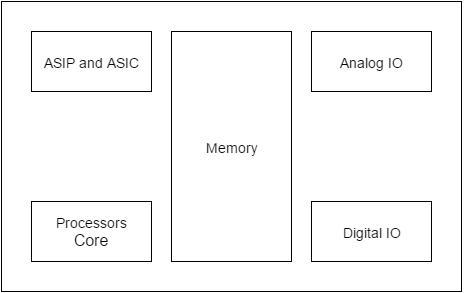
Q3) Compare 8-bit,16-bit,32-bit microcontrollers?
A3)
Most 8-bit processors are old architectures, so they tend to be slower. They are cheap. They also tend to have a low limit on supported RAM/other storage, but the actual amount depends on the family.
16-bit processors tend to focus on price as well, but there is a large range of parts available, some of which have fairly high performance and large amounts of on-chip peripherals. These parts usually perform faster than 8-bit parts on math where the precision is greater than 8 bits, and tend to have more addressable memory.
32-bit chips compete primarily on performance for an application. There is a considerable range of 32-bit parts available, each targeted at some specific application. They tend to come loaded with peripherals and compete on feature completeness. They have a large amount of addressable memory and the performance tends to be better than 16-bit parts.
Q4) With an example explain microcontrollers in embedded system?
A4)
Microcontroller is used inside an embedded system for managing the function of devices. Therefore, 8051 uses the two 16 bit counters and timers. For the operation of this timers and counters the oscillator used inside microcontroller.
Embedded System is a system unit that is used to create any automation device or to control any machines using Micro Controller.
Micro Controller is an Integrated Circuit that has a processor, Memory, Timer. A micro controller can be programmed with any dedicated task.
Consider the example of Washing Machine:
In a washing machine there are different functions that is programmed in a Micro Controller, like for rotating the motor and for automatic filling the water.
The whole circuit that uses different integrated circuit for different task can be called as Embedded System and the integrated circuit which is programmed for a dedicated task is called as a Micro Controller.
Q5) Compare Microprocessor and Microcontrollers.
A5)
| Microprocessor | Microcontroller |
System | It is the heart of the computer system, | It is the heart of an embedded system. |
Contains | It contains CPU, general purpose registers, stack pointers, program counters, clock timing and interrupt circuits. | It contains the circuitry of microprocessor and has built-in ROM, RAM, I/O devices, timers and counters. |
Data memory | It has many instructions to move data between memory and CPU | It has one or two instructions to move data between memory and CPU. |
Circuit | It is large | It is small |
Cost | Cost of the entire system increases | Cost of the entire system is low. |
Bit instructions | It has one- or two-bit handling instructions. | It has many bit handling instructions |
Register numbers | It has less number of registers; hence the operations are memory based. | It has more number of registers; hence the programs are easier to write. |
Storage | It is based on Von Neumann architecture, where the program and data are stored in the same memory module. | It is based on the Harvard architecture, where the program memory and data memory are stored in separate module |
Time | Access time for memory and I/O devices is more. | Less access time for built-in memory and I/O devices. |
Hardware | It requires more hardware | It requires less hardware. |
Q6) Explain the advantages of microcontroller?
A6)
i)Low time required for performing operation.
Ii)The processor chips are very small and flexibility occurs.
Iii)Due to their higher integration, cost and size of the system is reduced.
Iv)The microcontroller is easily to interface additional RAM, ROM and I/O ports.
Unit - 1
Fundamentals of Microcontrollers
Q1) Explain 8-bit Microcontroller architecture.
A1)
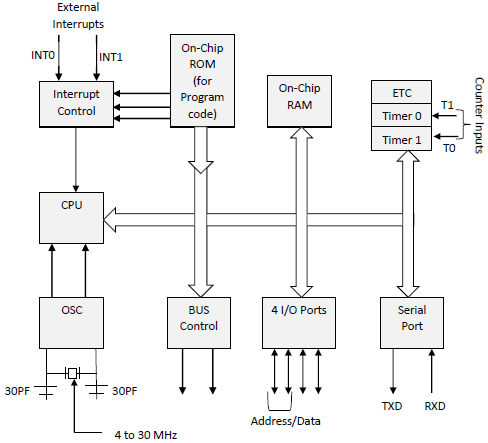
Fig 1: 8051 Architecture
Central Processor Unit (CPU)
The brain of any processing device of the microcontroller is the CPU. It monitors and controls all operations performed on these units. It reads a program written in ROM memory, executes and does the expected task.
Interrupts
Interrupt is a subroutine call that interrupts the microcontroller's main operations or work and causes it to execute any other program, at the time of operation. It provides a mechanism to put on hold the ongoing operations, execute a subroutine and resume to another type of operation.
8051 has five interrupt sources:
INTO
TFO
INT1
TF1
R1/T1
(INT0) ̅ and (INT1) ̅ are external interrupts negative edge triggered or low level triggered. When these interrupts are activated, the corresponding flags are set except for serial interrupts.
When the processor branches to ISR the interrupt flags are cleared. The external interrupts are timer and serial port interrupts.
Memory
They require memory to save as well as read so that the microcontroller performs specific operations of the task.
The memory which is used to store the program is known as code memory or Program memory. It is also known as ROM memory.
8051 data memory is used to store data temporarily for operation known as RAM memory. It has 4K of code memory or program memory and 128 bytes of data memory of RAM.
BUS
A collection of wires that work as a communication channel or medium for transfer of data. It consists of 8, 16 or more wires of microcontroller. Thus, they carry 8 bits or 16 bits of data simultaneously. There are two types of buses which are
Address Bus
Data Bus
Address Bus:
Microcontroller 8051 has a 16-bit address bus for transferring data. It addresses memory locations to transfer addresses from CPU to Memory. It has four addressing modes that are:
Immediate addressing modes.
Bank address (or) Register addressing mode.
Direct Addressing mode.
Register indirect addressing mode.
Data Bus: Microcontroller 8051 has 8 bits of data bus used to carry data for applications.
Oscillator
The 8051 microcontroller has an on-chip oscillator that acts as a clock source for the CPU of the microcontroller. The output pulses of the oscillator are stable. Therefore, it enables synchronized work for all the parts of the Microcontroller system.
Input/Output Port
To control the operation of machines, microcontrollers are used in embedded systems. To connect to other machines, devices or peripherals I/O interfacing ports is required. Microcontroller 8051 has 4 input and output ports to connect to other peripherals
Timers/Counters
The 8051 microcontroller has two 16-bit timers and counters. The counters are again divided into 8-bit registers. Timers are used for measurement of time intervals to determine pulse width.
Q2) Define embedded system and explain its characteristics?
A2)
An embedded system can be a computer hardware system having software embedded in it. An embedded system can be an independent system or it can be a part of a large system. An embedded system is a microcontroller or microprocessor based system designed to perform a specific task.
For example, let us consider the fire alarm as an embedded system. This system only senses smoke.
An embedded system consists of three components −
It has hardware.
It has application software.
It has a Real Time Operating system (RTOS) which defines the way the system works. It sets the rules during the execution of the application program. A small scale embedded system may not have RTOS.
Characteristics of an Embedded System
Single-functioned − An embedded system usually performs a specialized operation and does the same repeatedly. For example: A pager always functions as a pager.
Tightly constrained − All computing systems have constraints on design metrics, but those on an embedded system can be especially tight. Design metrics is a measure of an implementation's features such as its cost, size, power, and performance
Reactive and Real time − Many embedded systems must continually react to changes in the system's environment and must compute certain results in real time without any delay.
Memory − It must have a memory, as its software usually embeds in ROM. It does not need any secondary memories in the computer.
Connected − It must have connected peripherals to connect input and output devices.
HW-SW systems − Software is used for more features and flexibility. Hardware is used for performance and security.
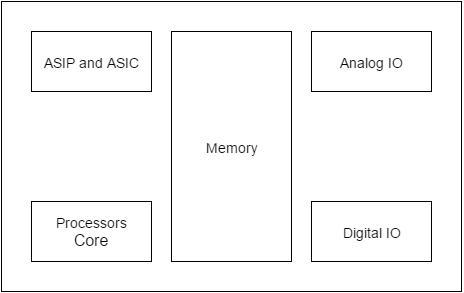
Q3) Compare 8-bit,16-bit,32-bit microcontrollers?
A3)
Most 8-bit processors are old architectures, so they tend to be slower. They are cheap. They also tend to have a low limit on supported RAM/other storage, but the actual amount depends on the family.
16-bit processors tend to focus on price as well, but there is a large range of parts available, some of which have fairly high performance and large amounts of on-chip peripherals. These parts usually perform faster than 8-bit parts on math where the precision is greater than 8 bits, and tend to have more addressable memory.
32-bit chips compete primarily on performance for an application. There is a considerable range of 32-bit parts available, each targeted at some specific application. They tend to come loaded with peripherals and compete on feature completeness. They have a large amount of addressable memory and the performance tends to be better than 16-bit parts.
Q4) With an example explain microcontrollers in embedded system?
A4)
Microcontroller is used inside an embedded system for managing the function of devices. Therefore, 8051 uses the two 16 bit counters and timers. For the operation of this timers and counters the oscillator used inside microcontroller.
Embedded System is a system unit that is used to create any automation device or to control any machines using Micro Controller.
Micro Controller is an Integrated Circuit that has a processor, Memory, Timer. A micro controller can be programmed with any dedicated task.
Consider the example of Washing Machine:
In a washing machine there are different functions that is programmed in a Micro Controller, like for rotating the motor and for automatic filling the water.
The whole circuit that uses different integrated circuit for different task can be called as Embedded System and the integrated circuit which is programmed for a dedicated task is called as a Micro Controller.
Q5) Compare Microprocessor and Microcontrollers.
A5)
| Microprocessor | Microcontroller |
System | It is the heart of the computer system, | It is the heart of an embedded system. |
Contains | It contains CPU, general purpose registers, stack pointers, program counters, clock timing and interrupt circuits. | It contains the circuitry of microprocessor and has built-in ROM, RAM, I/O devices, timers and counters. |
Data memory | It has many instructions to move data between memory and CPU | It has one or two instructions to move data between memory and CPU. |
Circuit | It is large | It is small |
Cost | Cost of the entire system increases | Cost of the entire system is low. |
Bit instructions | It has one- or two-bit handling instructions. | It has many bit handling instructions |
Register numbers | It has less number of registers; hence the operations are memory based. | It has more number of registers; hence the programs are easier to write. |
Storage | It is based on Von Neumann architecture, where the program and data are stored in the same memory module. | It is based on the Harvard architecture, where the program memory and data memory are stored in separate module |
Time | Access time for memory and I/O devices is more. | Less access time for built-in memory and I/O devices. |
Hardware | It requires more hardware | It requires less hardware. |
Q6) Explain the advantages of microcontroller?
A6)
i)Low time required for performing operation.
Ii)The processor chips are very small and flexibility occurs.
Iii)Due to their higher integration, cost and size of the system is reduced.
Iv)The microcontroller is easily to interface additional RAM, ROM and I/O ports.